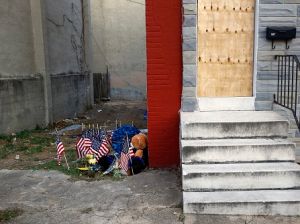
BALTIMORE (AP) — The murder of a Baltimore homicide detective shot in the head with his own gun two weeks ago has transformed into a feeding frenzy of speculation in a city filled with armchair sleuths and deeply suspicious views of law enforcers.
The unsolved Nov. 15 killing of Detective Sean Suiter is the talk of Baltimore, where residents are dissecting details of the case in offices, on street corners and on social media. It’s a homicide investigation, but the version of events offered up by police brass is being increasingly questioned since it came to light that the detective was shot a day before he was set to testify before a federal grand jury probing an elite unit of indicted officers.
Police Commissioner Kevin Davis has emphasized that Suiter, whose Baltimore-area funeral procession was set to close down major roads Wednesday, was not the target of any federal probe and by all accounts was a “stellar detective.” He said he understands the “wild possibilities that go through people’s minds when we all want answers” but stressed that the evidence refutes any notion that the slaying in a high-crime neighborhood was “part of any conspiracy.”
“There’s no path that we won’t go down if evidence takes us down that path. But right now, the evidence that’s available to us is indicative of a homicide,” Davis said.
But with the revelation of Suiter’s planned testimony before a grand jury and no arrests even with a $215,000 reward, there appears to be no end in sight to the rumor mill in a city accustomed to watching their streets as the setting for gritty TV crime dramas. The Baltimore Police Department has also had a tense relationship with many citizens in the majority-black city for decades. Baltimore and the Justice Department entered into a reform agreement earlier this year after a scathing report by the federal agency outlined widespread police misconduct and abuse.
“For all the years these cops have been running around here, they can’t catch this guy they say took out one of their own? I don’t believe what they’re saying,” said Mike Williams, a resident of the blighted Harlem Park neighborhood as he watched a TV crew set up by the lot where Suiter was shot at close range while investigating a 2016 triple homicide.
Located between row houses, the lot now has a small shrine with a dozen American flags and some flowers. The community was on lockdown for days as investigators scoured for evidence and searched the area’s numerous dilapidated, boarded-up homes.
Rumors about Suiter’s killing went into overdrive when Davis confirmed last week that the acting U.S. attorney and FBI informed him that the detective was gunned down a day before he was to testify in an ongoing probe of a specialized gun recovery unit. Eight indicted Baltimore officers, including four who have pleaded guilty to racketeering, are accused of defrauding their department, falsifying evidence and shaking down citizens. The same week Suiter was shot, a Philadelphia officer became the ninth officer indicted in the probe of Baltimore’s Gun Trace Task Force.
Some people, including gossiping law enforcers, have speculated that Suiter might have shot himself, staging a suicide to look like a murder. Others envision a conspiracy where Suiter was labeled a traitor by dirty colleagues for turning against them.

Peter Moskos, an associate professor at John Jay College of Criminal Justice who served as a Baltimore police officer from 1999 to 2001, said he believed that imaginations were mostly running wild. The timeline of events in the case seem to fall “somewhere between standard operational chaos, where they don’t know what happened, and even proper response,” he said.
But the fact that Suiter was due to testify the day after he was shot appears to be “a hell of a coincidence,” he said.
Deepening the mystery, court records show that the 18-year police veteran had worked on cases with some of the indicted officers.
The Baltimore Sun first reported that federal authorities have reopened a 2010 case investigated by Suiter and one of the accused task force officers, Wayne Jenkins, involving a drug arrest and a fatal car collision.
On the day of Suiter’s shooting, police say he and his partner were working in a particularly rough section of West Baltimore. They wore badges and were dressed in suits and ties, as is standard for detectives.
Davis said Suiter approached a “suspicious” man in a vacant lot, leading to a violent confrontation in which he was shot with his own gun. Private video surveillance shows Suiter’s partner taking cover across the street at the time of the shooting, according to the police commissioner.
Suiter was found clutching his radio with his left hand. A garbled three-second-long radio transmission indicated he was in distress and his clothes had signs of a “violent struggle,” Davis said.
The father of five died at a hospital a day later.
Investigators recovered Suiter’s weapon, which had been fired three times.
Police say they only have the barest outlines of the shooter: A man wearing a black jacket with a white stripe. They believe the attacker might have been wounded and they have searched emergency rooms and doctors’ offices during their manhunt.
With the mystery deepening two weeks since the shooting, there are many in Baltimore who have a hard time believing the official version of events about Suiter’s end.
“I feel very bad for this man, his family. But it’s also like this where I come from in El Salvador: The story that gets told is not so much the real story,” said Toni Sanchez, who lives with his family near the lot where Suiter became Baltimore’s latest body to fall amid a year that has seen so many.
Like BlackAmericaWeb.com on Facebook. Follow us on Twitter and Instagram
Sign Up For Our Newsletter!
(Baltimore Police Department via AP & AP Photo/Patrick Semansky)
















